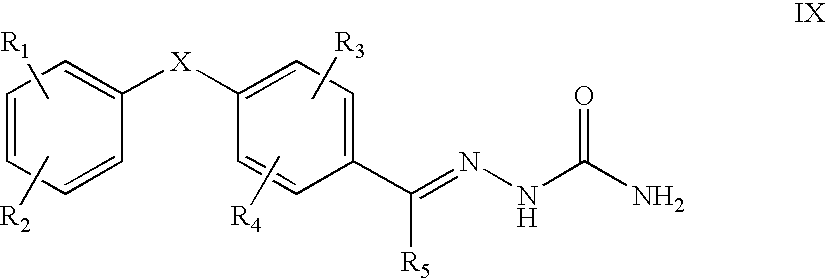Carbocyclic and heterocyclic substituted semicarbazones and thiosemicarbazones and the use thereof
a technology of semicarbazones and thiosemicarbazones, which is applied in the field of carbocyclic and heterocyclic substituted semicarbazones and thiosemicarbazones, and can solve the problems that their mechanism of action has not been elucidated
- Summary
- Abstract
- Description
- Claims
- Application Information
AI Technical Summary
Benefits of technology
Problems solved by technology
Method used
Image
Examples
example 1
4-(4-Chloro-2-pyridinoxy)benzaldehyde semicarbazone
a) 4-(4-Chloro-2-pyridinoxy)benzaldehyde: To a solution of 4-fluorobenzaldehyde (3.6 g, 29 mmol) in N,N-dimethylacetamide (25 mL) was added 5-chloro-2-pyridinol (4.1 g, 32 mmol) and K.sub.2 CO.sub.3 (4.1 g, 30 mmol) at room temperature under argon. The mixture was heated to reflux for 4 h, cooled to room temperature, diluted with ethyl acetate (150 mL), washed with water and brine, dried over Na.sub.2 SO.sub.4, and concentrated in vacuo. The residue was purified by chromatography to yield the title compound as a white solid (0.59 g, 2.5 mmol, 8%). .sup.1 H NMR (CDCl.sub.3): .delta. 9.99 (s, 1H), 8.16 (s, 1H), 7.94 (d, J=7.7, 2H), 7.27 (d, J=7.7, 2H), 7.71 (d, J=8.6, 1H), 6.99 (d, J=8.6, 1H).
b) 4-(4-Chloro-2-pyridinoxy)benzaldehyde semicarbazone: To a solution of 4-(4-chloro-2-pyridinoxy)benzaldehyde (330 mg, 1.41 mmol) in ethanol (10 mL) was added a solution of semicarbazide hydrochloride (213 mg, 1.84 mmol) and sodium acetate trihy...
example 2
4-(4-Pyridinoxy)benzaldehyde semicarbazone
a) 4-(4-Pyridinoxy)benzaldehyde: To a solution of 4-hydroxybenzaldehyde (2.8 g, 23 mmol) in N,N-dimethylacetamide (30 mL) was added 4-chloropyridine hydrochloride (3.4 g, 23 mmol) and K.sub.2 CO.sub.3 (5.0 g, 36 mmol) at room temperature under argon. The mixture was heated to reflux for 6 h, cooled to room temperature, diluted with ethyl acetate (75 mL), washed with water, 2N NaOH and brine, dried over Na.sub.2 SO.sub.4, and concentrated in vacuo. The residue was purified by chromatography to yield the title compound as a colorless liquid (0.57 g, 2.9 mmol, 13%). .sup.1 H NMR (CDCl.sub.3): .delta. 10.00 (s, 1H), 8.56 (d, J=6.0, 2H), 7.96 (d, J=8.5, 2H), 7.23 (d, J-8.5, 2H), 6.93 (d, J=6.0, 2H).
b) 4-(4-Pyridinoxy)benzaldehyde semicarbazone: To a solution of 4-(4-pyridinoxy)benzaldehyde (570 mg, 2.86 mmol) in ethanol (10 mL) was added a solution of semicarbazide hydrochloride (350 mg, 3.03 mmol) and sodium acetate (235 mg, 2.86 mmol) in water ...
example 3
4-(3-Pyridinoxy)benzaldehyde semicarbazone
a) 4-(3-pyridinoxy)benzaldehyde: A mixture of 4.02 g (42.3 mmol) of 3-hydroxypyridine, 5.40 g (43.5 mmol) of 4-fluorobenzaldehyde and 5.92 g (42.8 mmol) of anhydrous potassium carbonate in dimethylacetamide (40 mL) was refluxed (.about.180.degree. C.) overnight. It was cooled to room temperature, and poured into water (50 mL). The mixture was extracted with 1:1 hexane / ethyl acetate (2.times.50 mL). The combined extract was washed with water (50 mL), 0.4 N NaOH (50 mL) and water (50 mL), dried (NaSO.sub.4) and evaporated to leave 7.62 g of oil, which was used for the next reaction.
b) 4-(3-Pyridinoxy)benzaldehyde semicarbazone: To a solution of 659 mg (3.31 mmol) of the oil in absolute ethanol (10 mL) was added dropwise a solution of 369 mg (3.31 mmol) of semicarbazide hydrochloride and 274 mg (3.31 mmol) of sodium acetate in water (3 mL). The solution was stirred at room temperature for 2 h to give white precipitates. The mixture was filtered...
PUM
| Property | Measurement | Unit |
|---|---|---|
| thick | aaaaa | aaaaa |
| temperature | aaaaa | aaaaa |
| pH | aaaaa | aaaaa |
Abstract
Description
Claims
Application Information
 Login to View More
Login to View More - R&D
- Intellectual Property
- Life Sciences
- Materials
- Tech Scout
- Unparalleled Data Quality
- Higher Quality Content
- 60% Fewer Hallucinations
Browse by: Latest US Patents, China's latest patents, Technical Efficacy Thesaurus, Application Domain, Technology Topic, Popular Technical Reports.
© 2025 PatSnap. All rights reserved.Legal|Privacy policy|Modern Slavery Act Transparency Statement|Sitemap|About US| Contact US: help@patsnap.com



